Long Tien Pagoda: Ha Long Bay's Spiritual Haven Beneath Poem Mountain
Nestled at the foot of the famous Poem Mountain (Núi Bài Thơ) in Ha Long City, Long Tien Pagoda stands as a testament to Vietnam's rich cultural heritage and enduring spiritual traditions. While Ha Long Bay's limestone karsts and emerald waters draw millions of visitors annually, this remarkable pagoda offers a different yet equally enriching glimpse into the soul of Quang Ninh Province. As the largest pagoda in Ha Long City, Long Tien has become an essential stop for both devout pilgrims and curious travelers seeking to experience the authentic spiritual life of local communities beyond the bay's natural splendors.
1. The Historical Foundation of Long Tien Pagoda
Unlike many ancient Vietnamese pagodas that date back several centuries, Long Tien Pagoda has a relatively recent history. Constructed in 1941, the pagoda represents a more modern expression of Vietnam's enduring Buddhist traditions. Its establishment during the mid-20th century—a period of significant historical change in Vietnam—speaks to the resilience of religious practices even in times of social transformation.
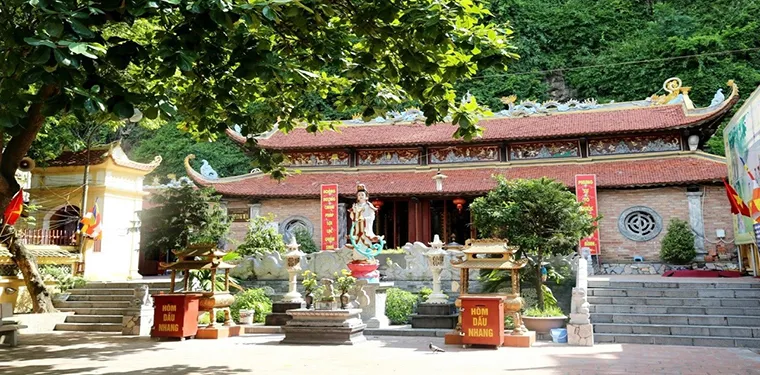
Built in 1941, Long Tien Pagoda reflects Vietnam’s enduring Buddhist traditions and resilience through historical changes - Photo Source: chonthieng.com
The pagoda's name, "Long Tien," carries significant cultural meaning. In Vietnamese, "Long" refers to dragons—mythical creatures deeply embedded in Vietnamese cultural identity and often associated with divine power and protection. "Tien" can be interpreted as "fairy" or "immortal," suggesting a celestial quality. Together, the name evokes a spiritual space that bridges the earthly and divine realms, a fitting designation for a site dedicated to religious practice and contemplation.
2. Architecture and Sacred Spaces
The pagoda's distinctive Nguyen Dynasty architectural style is immediately apparent to visitors approaching its impressive triple-arched entrance gate (tam quan). This imposing gateway is crowned with a Buddha statue at its highest point, creating a spiritually significant threshold between the secular world outside and the sacred grounds within.
Below the entrance arch sits a bell tower, adorned with the three Chinese characters "Long Tien Tu" (Long Tien Pagoda) and flanked by two parallel horizontal inscribed boards. This elegant bell tower serves both practical and symbolic purposes—its resonant tones mark the rhythm of daily prayers while spiritually cleansing the surrounding area of negative energies.
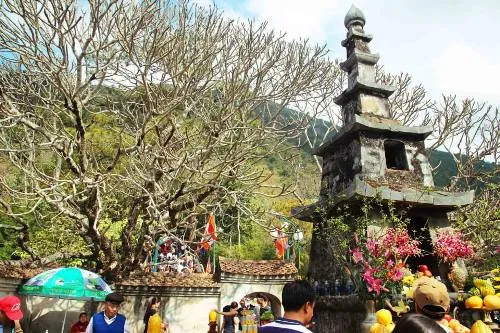
The pagoda showcases Nguyen Dynasty architecture with a grand entrance gate, bell tower, and altars blending Buddhist and folk religious elements - Photo Source: chonthieng.com
Inside, the pagoda's main sanctuary is dedicated primarily to Buddha worship, maintaining the central Buddhist focus of the temple. However, reflecting the syncretic nature of Vietnamese religious practices, the pagoda also includes separate altars that honor other significant figures. To the right of the main altar stands a shrine dedicated to generals from the Tran Dynasty—a nod to Vietnam's heroic military past. The left side houses an altar for the Three Realm Holy Mothers (Tam Toa Thanh Mau), incorporating elements of Vietnam's indigenous Mother Goddess worship tradition.
This thoughtful arrangement of sacred spaces demonstrates how Vietnamese religious sites often blend Buddhist traditions with folk beliefs and historical reverence, creating spiritually complex environments that address multiple aspects of community life. The craftsmanship throughout the pagoda is noted for its aesthetic beauty, with intricately carved wooden elements and carefully rendered sacred imagery.
3. Visitor Experience and Spiritual Significance
For visitors to Long Tien Pagoda, the experience transcends simple sightseeing. The temple offers an opportunity to witness and participate in authentic religious practices that have been meaningful to local communities for generations. Travelers can observe or join in traditional rituals such as offering incense, meditating before sacred altars, and listening to the resonant tones of the temple bell—each activity designed to create moments of spiritual connection and inner peace.
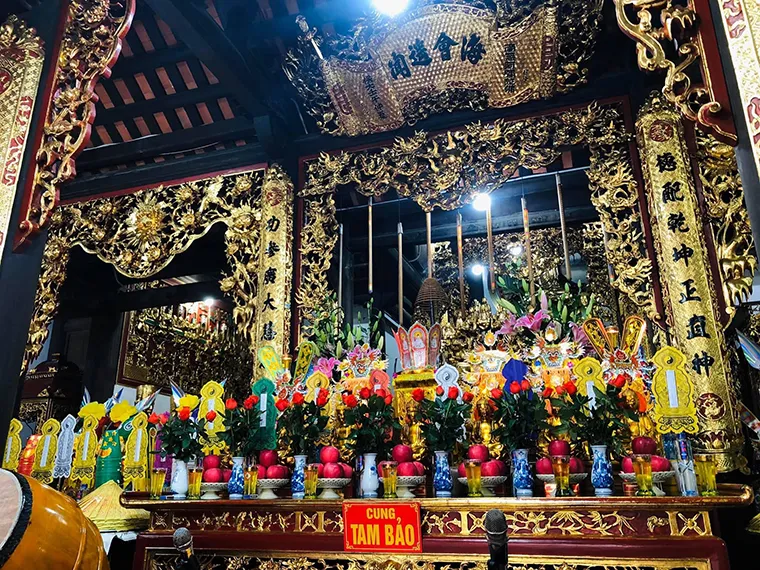
Visitors can experience authentic religious rituals, find inner peace, and enjoy the serene setting beneath Poem Mountain - Photo Source: chonthieng.com
The pagoda's location at the foot of Poem Mountain (Núi Bài Thơ) adds another dimension to the visitor experience. After exploring the spiritual spaces of Long Tien, travelers can ascend the mountain for panoramic views of Ha Long Bay, creating a journey that combines spiritual enrichment with natural beauty. This geographical positioning near both the famous bay and Ha Long Market makes it easily accessible to visitors and integrates it into the broader tourist experience of the region.
The spiritual significance of Long Tien extends beyond formal religious observances. For many locals, the pagoda represents a sanctuary of calm and continuity in an increasingly modernizing world. It serves as a repository of cultural values, a place where traditional wisdom is preserved and passed to younger generations through both formal teachings and lived examples of devotional practice.
4. Practical Information for Visitors
4.1. Location and Access
Long Tien Pagoda is located on Le Quy Don Street in Bach Dang Ward, Ha Long City, Quang Ninh Province, Vietnam. Its precise geographic coordinates are 20.9498047, 107.0803428. The pagoda sits near the foot of Poem Mountain and close to Ha Long Market, making it easily accessible for visitors exploring the central areas of Ha Long City.
4.2. Opening Hours and Etiquette
The pagoda welcomes visitors from early morning until late evening, making it accessible regardless of your daily schedule. However, for the most peaceful experience, early morning visits are recommended when the atmosphere is particularly serene and conducive to spiritual reflection.
When visiting Long Tien Pagoda, appropriate dress and behavior are essential signs of respect. Modest clothing that covers shoulders and knees is recommended. Visitors should speak quietly, move gently through the space, and be mindful not to disrupt those engaged in prayer or meditation. Photography is generally permitted in the main areas, but it's always best to seek permission before photographing specific ceremonies or individual worshippers.

Located in Ha Long City, the pagoda is easily accessible, with recommended early morning visits and respectful dress code - Photo Source: Facebook Chùa Long Tiên - TP Hạ Long
4.3. Best Times to Visit
While Long Tien Pagoda welcomes visitors year-round, certain times offer especially meaningful experiences:
-
Lunar New Year (Tet): Usually falling in January or February, this period showcases the pagoda at its most vibrant, with elaborate decorations and continuous ceremonial activities.
-
The 1st and 15th days of each lunar month: These regular observance days provide glimpses into the rhythm of traditional Buddhist practice without the overwhelming crowds of major festivals.
-
Annual Festival (24th day of the 3rd lunar month): This significant celebration features unique cultural performances and religious ceremonies, though visitors should be prepared for larger crowds.
-
Spring months: Following Tet, the spring period is traditionally associated with pagoda visits in Vietnamese culture, creating a festive atmosphere as pilgrims move between sacred sites in the region.
For those seeking tranquility, weekday mornings outside major festival periods offer the most contemplative atmosphere, with fewer visitors and a palpable sense of peace throughout the grounds.
5. Exploring Beyond Long Tien Pagoda
A visit to Long Tien Pagoda can be beautifully integrated into a broader exploration of Ha Long's cultural and natural landscapes. After experiencing the spiritual ambiance of the pagoda, consider these complementary activities:
-
Climb Poem Mountain: The pagoda sits at the base of this famous landmark, which offers spectacular views of Ha Long Bay and city. The mountain's name derives from poems carved into its stone by ancient visitors, including one by Emperor Le Thanh Tong in 1468.
-
Visit Quang Ninh Museum: Located nearby, this striking modern building (often called the "Black Pearl" for its distinctive architecture) houses extensive exhibits on the region's natural history, cultural heritage, and coal mining industry.
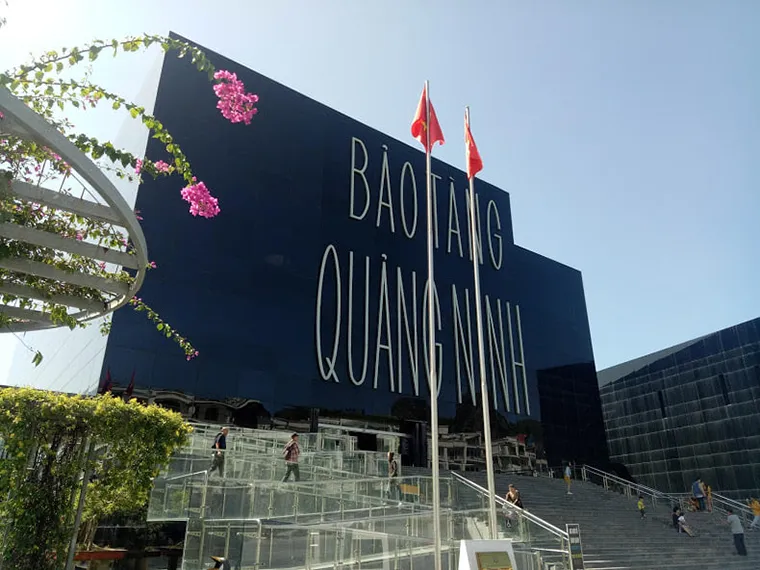
Nearby attractions like Poem Mountain, Quang Ninh Museum, and Ha Long Market enrich the cultural journey - Photo Source: Facebook Bảo Tàng Tỉnh Quảng Ninh
-
Explore Ha Long Market: Just a short walk from the pagoda, this bustling marketplace offers insights into local daily life and the opportunity to sample regional specialties.
-
Take a Heritage Walk: The surrounding Bach Dang Ward contains several historical sites related to Vietnam's resistance against foreign invasions, adding historical context to your cultural exploration.
Consider a visit to Vung Vieng Fishing Village Ha Long to experience the unique culture of a floating community in the bay. From there, take a scenic boat ride to Gia Luan Harbor Cat Ba, a tranquil gateway to the island’s lush landscapes and charming villages - an ideal extension to your Northern Vietnam adventure.
By combining these experiences, visitors can develop a more nuanced understanding of Ha Long beyond its famous bay, appreciating how natural beauty, spiritual traditions, and historical significance intertwine in this remarkable region of Vietnam.
6. The Living Tradition of Long Tien Pagoda
What makes Long Tien Pagoda particularly special is not just its physical structures or historical significance, but its role as a living center of continuous religious practice. Unlike some heritage sites that primarily serve as museums of past traditions, Long Tien remains vibrantly active in the spiritual lives of Ha Long's residents.
On any given day, visitors might observe multiple generations of families coming together to pray—grandparents teaching younger family members the proper way to offer incense, parents explaining the significance of particular deities, and children absorbing these cultural practices through participation. These intergenerational moments of shared devotion ensure the transmission of both formal religious knowledge and the subtle cultural understandings that accompany it.
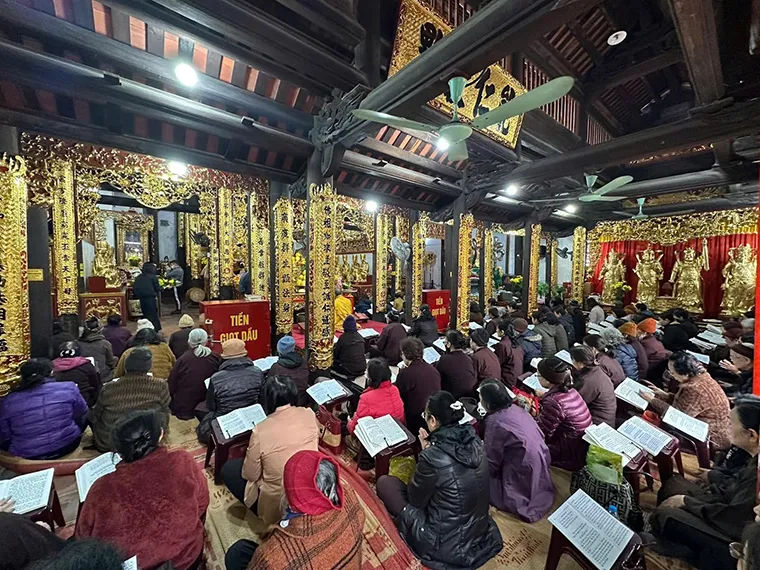
The pagoda remains an active spiritual center, fostering intergenerational devotion and preserving religious practices - Photo Source: Chùa Long Tiên - TP Hạ Long
The monks and caretakers of Long Tien contribute significantly to this living tradition, maintaining not just the physical space but also the proper performance of rituals and the preservation of associated knowledge. Their presence creates continuity with Buddhist lineages that stretch back through centuries of Vietnamese history, even as they adapt to serve the needs of contemporary practitioners.
For travelers interested in Vietnamese spiritual culture, this living quality makes Long Tien Pagoda particularly valuable. Rather than simply observing static artifacts of faith, visitors can witness and respectfully engage with authentic religious practices as they unfold naturally in a community setting. This immersive experience offers insights into the ways spiritual beliefs continue to shape Vietnamese identity and community life in the 21st century.
7. Photography Tips for Visitors
Long Tien Pagoda offers numerous photographic opportunities for travelers wishing to document their visit. To capture the essence of this spiritual site while maintaining appropriate respect:
-
Morning light: The soft, golden light of early morning beautifully illuminates the pagoda's entrance gate and main buildings, creating dramatic shadows and highlighting architectural details.
-
Ceremonial moments: With permission, respectfully photograph incense offerings, prayer sessions, or bell-ringing ceremonies to capture the living spiritual practices of the site.
-
Architectural details: Focus on the intricate craftsmanship of wooden carvings, decorative elements, and altar arrangements that showcase traditional Vietnamese artistic traditions.
-
Contextual views: Include images that situate the pagoda in its natural setting beneath Poem Mountain to convey its unique geographical position.
Remember that while photography is generally permitted in public areas, always prioritize respect for worshippers. Avoid using flash photography inside temple buildings, ask permission before photographing individuals at prayer, and be prepared to put your camera away during particularly sacred ceremonies.
8. Conclusion
In a region primarily celebrated for its natural wonders, Long Tien Pagoda offers visitors a complementary but equally valuable experience—the chance to connect with Vietnam's spiritual heritage and living religious traditions. While the limestone karsts of Ha Long Bay speak to nature's creative power, this pagoda reveals how human communities have created meaning through ritual, architecture, and communal devotion.
For travelers seeking a more comprehensive understanding of Vietnamese culture, Long Tien Pagoda provides essential insights into the religious practices that continue to structure daily life and seasonal celebrations for many local residents. Its relatively recent construction compared to ancient pagodas elsewhere in Vietnam demonstrates how spiritual traditions remain vibrant and relevant even in contemporary settings.
Whether you come as a pilgrim seeking blessings, a cultural explorer interested in religious practices, or simply a curious traveler open to new experiences, Long Tien Pagoda welcomes you to slow down, observe, and perhaps participate in the rhythms of spiritual life that have sustained Vietnamese communities for generations. In doing so, you may discover that beyond Ha Long's famous landscapes lies an equally beautiful cultural terrain, rich with meaning and alive with tradition.
|
Joytime Travel Agency - Travel JOY, TIMEless Vietnam Follow us for travel tips, local insights, and exclusive offers:
|

Danish Nguyen
Danish Nguyen is a renowned travel blogger in Vietnam with over 5 years of experience sharing unique travel experiences. With a passion for exploring new places, Danish captures incredible moments and provides readers with valuable tips to discover the beauty of his homeland.








.webp)
.webp)








